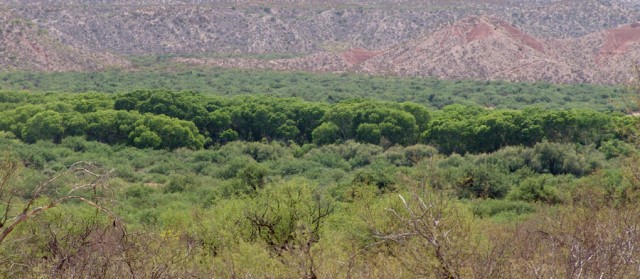gallery (galeria) forests
GALLERY FORESTS are commonly defined as any forest along a river or stream, especially in a grassland. Since geographers frequently cite BRAZIL as the best example of this phenomenon, we often use the Portuguese word galeria to identify it. Gallery forests are also found in places other than Brazil. For example, an article in the journal Landscape Ecology, discussing gallery forest expansion in KANSAS, quotes the Spanish explorer Francisco Coronado as saying in 1541, “There is not any kind of wood in all these plains, away from the gullies and rivers, which are very few.” Gallery forests are common in tropical Africa, too.
Brazil's Amazon basin is covered mostly by tropical RAINFOREST. To the south, many tributaries of the AMAZON RIVER flow northward through tropical savanna GRASSLANDS. Detailed vegetation maps of Brazil show fingerlike extensions of tropical rainforest protruding from the Amazon along the banks of these tributary rivers. These protrusions are called gallery forests. On smaller streams, the crowns of gallery forest trees interlock above the stream. If you were to float down such a stream, you would travel through a long green tunnel or gallery of vegetation.

Tropical rainforests typically exhibit tremendous biological diversity. A small patch may contain many species of trees. These trees are tall and form a leafy canopy 100 ft (30 m) or more above the ground. This canopy prevents much sunlight from reaching the forest floor, which generally has limited amounts of undergrowth. Wherever sunlight does reach the forest floor, however, a profusion of bushy plants known as jungle vegetation is the result. One place where this occurs is along the banks of large rivers. Tropical gallery forests, therefore, contain plenty of jungle vegetation.
Many of the animals that make the gallery forest their home live in the canopy. Arboreal animals are well adapted to life in the trees. South American monkeys, for example, have prehensile tails to help them grasp tree limbs. Birds seek foods such as the seeds in fruits or tree-dwelling insects.
Most trees in Brazil's gallery forests share some common traits. They are mostly hygrophytic (waterloving), well suited to an environment that undergoes prolonged flooding each year. Most are dense hardwoods such as mahogany and teak, prized by lumber merchants for such uses as flooring, cabinetmaking, boatbuilding and interior trim. Exploiting this resource is a challenge, however. First, the trees do not occur in pure stands. Second, once found and cut down, they are difficult to transport to the sawmill. Because the wood is so dense, the logs will not float. Despite these difficulties, loggers feel that the effort is worthwhile, since a single tree may fetch several thousand dollars.
Loggers are taking even the less desirable trees, converting the wood into charcoal for use in one of Brazil's iron smelters. Gold mining and other mining activities complicate the picture. Not only do mines scar the surface of the Earth, the mercury that the miners use to process the gold pollutes the rivers. Fish take up the poisonous mercury, making them unfit for human consumption.
CONTROVERSIAL POLICIES
Controversies have developed concerning the best policies for the Brazilian government to implement with respect to the Native Americans living in the forests. Many of these indigenous people, though migratory, prefer to live in villages along the banks of rivers, where they can maximize protein intake through fishing and hunting. Such a location exposes them to exploitation and harm by outsiders. Although the government has implemented safeguards for the natives, federal agencies have limited resources for enforcement. So the natives are faced with a dilemma: retreat deep into the rainforest, where resources may be more scarce, or stay where they are and suffer the possible negative consequences.
Geographic scientists are dismayed to see the steady destruction of Brazil's rainforests and gallery forests. They point to such problems as the disappearance of plants that may have medicinal value, the shrinkage of habitat for animals, the climatic consequences in terms of accelerated global warming and decreased rainfall, soil erosion, and possible job losses because sustainable economic development may no longer be possible. Estimates made from study of the latest satellite images suggest that Brazil's forests may disappear well before the end of the twenty-first century, much sooner than originally predicted.